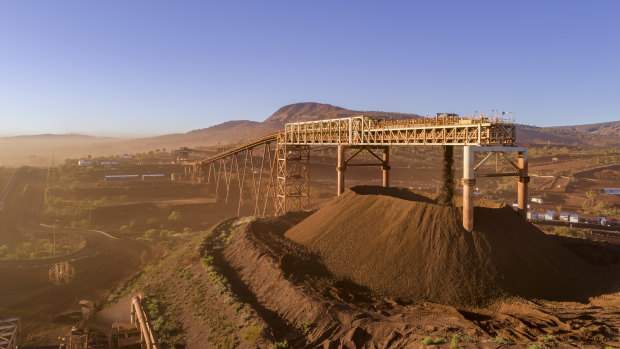Save articles for later
Add articles to your saved list and come back to them any time.
Plummeting prices for key exports are on track to deliver the country a $116 billion revenue cut over the next 18 months, hitting an economy already struggling with the Reserve Bank’s aggressive tightening of monetary policy.
As the RBA considers its first interest rate move since June on Tuesday, Industry Department forecasts of a $67 billion drop in earnings from resources and energy exports this financial year and a further hit of more than $48 billion in 2024-25 highlight the perils facing the economy.
Exports of Australian resources such as iron ore are forecast to fall in value by $116 billion, delivering a hit to the economy and the budget.
A global economic slowdown, caused largely by central banks lifting interest rates in an effort to bring inflation under control, and the troubled Chinese property market are contributing to the expected drop-off in export earnings.
The forecasts point to pressure on the federal budget, which just recorded its first surplus in 15 years, and the broader economy, with unemployment already expected to rise as the impact of past increases in interest rates hits the nation’s job market. Last year’s surplus was driven by a lift in tax collections, particularly from the resources sector.
Thermal coal exports alone, which reached $66 billion last financial year as prices rose in part due to Russia’s invasion of Ukraine, are tipped to more than halve over the next 18 months to $28 billion.
The value of iron ore, Australia’s single largest export, is expected to fall from $124 billion to $99 billion despite increased production. LNG prices are also tipped to drop sharply, taking export values down to $63 billion from $92 billion.
Resources Minister Madeleine King said the downgrade to exports reflected a return to more normal prices for key resources and an easing in supply problems.
“While overall export revenue is easing from record highs, Australia’s resources and energy exports remain strong and continue to underpin Australia’s economic wellbeing,” she said.
One of the few expected bright spots is exports of minerals tied to the rapidly growing electric vehicle sector. Exports of lithium are expected to jump by a fifth by 2024-25, although the value of those exports is forecast to fall due to an expected drop in prices.
The lower prices for key exports, the Industry Department noted, would take some pressure off global inflation, which soared after Russia invaded Ukraine last year.
The average price for unleaded petrol has climbed by more than 20 cents a litre over the past month.Credit: James Davies
At the monthly level, inflation in Australia pushed up to 5.2 per cent in August, largely because of the jump in oil prices that has flowed through to the pump. Last week, the national capital city average price for a litre of unleaded petrol climbed to 211.8¢. A month earlier, it had been under $1.90.
But there are some signs that overall inflation pressures are easing. The closely watched Melbourne Institute monthly inflation gauge showed no change in consumer prices through September.
The gauge, which closely tracks the official measure of inflation, showed overall prices across all household groups, including pensioners and working families, were flat last month. Its measures of underlying inflation, which exclude volatile items such as oil, also showed further declines.
Reserve Bank governor Michele Bullock will chair her first board meeting on Tuesday. Financial markets and most economists expect official interest rates to remain at 4.1 per cent.
AMP chief economist Shane Oliver believes the Reserve Bank’s next move on rates will be a cut, probably in June next year.
He said the RBA’s previous rate increases had reduced the capacity of a borrower to pay for a property by almost a third since April last year, putting at risk the entire housing market.
“The rapid reversal in the capacity to pay since May last year due to the surge in mortgage rates threatens a downwards adjustment in home prices at some point unless incomes rise dramatically or mortgage rates fall dramatically,” Oliver said.
“There is a high risk of increased listings by distressed sellers – this may come from variable rate borrowers and the rollover of fixed-rate mortgages.”
Cut through the noise of federal politics with news, views and expert analysis. Subscribers can sign up to our weekly Inside Politics newsletter.
Most Viewed in Politics
From our partners
Source: Read Full Article


